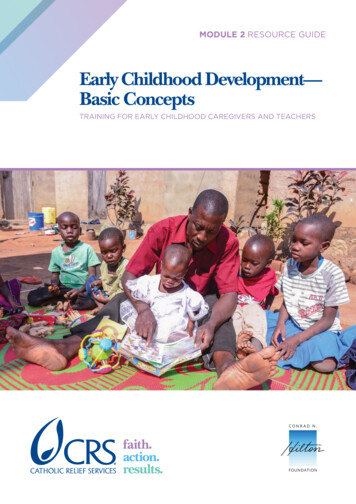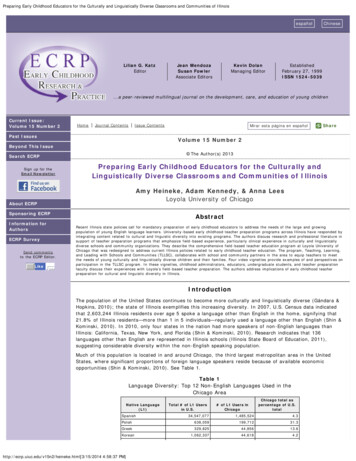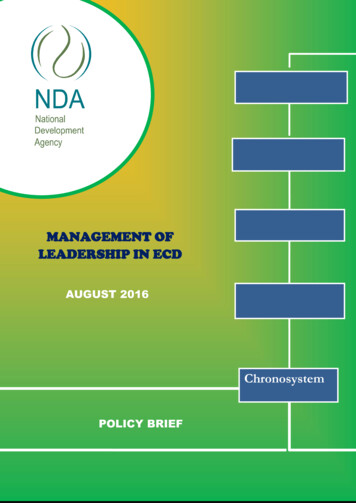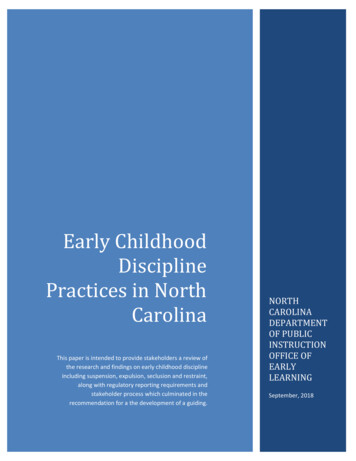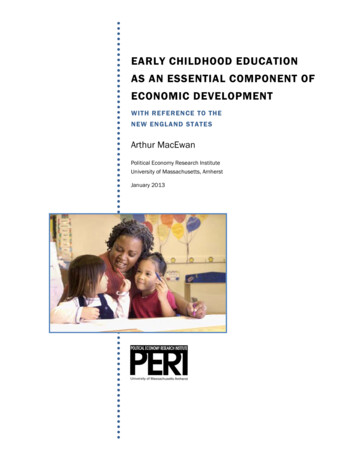
Transcription
EARLY CHILDHOOD EDUCATIONAS AN ESSENTIAL COMPONENT OFECONOMIC DEVELOPMENTWITH REFERENCE TO THENEW ENGLAND STATESArthur MacEwanPolitical Economy Research InstituteUniversity of Massachusetts, AmherstJanuary 2013
“From birth to age 5, children rapidly develop foundational capabilities on which subsequent development builds. In addition to their remarkable linguistic and cognitivegains, they exhibit dramatic progress in their emotional, social, regulatory, and moralcapacities. All of these critical dimensions of early development are intertwined, andeach requires focused attention.”Committee on Integrating the Science of Early Childhood Development,From Neurons to Neighborhoods: The Science of Early ChildhoodDevelopment1“The most valuable lesson advocates for preschool education can take away from theearly intervention studies is not to oversell the potential benefits.”Edward Zigler, “A Warning Against Exaggerating the Benefits of PreschoolEducation Programs”2“ there are some policies that both are fair—i.e., promote equity—and promote economic efficiency. Investing in the early years of disadvantaged children’s lives is onesuch policy.”“Parents need help and their children will suffer if they don’t get it. Society will pay theprice in higher social costs and declining economic fortunes.”James J. Heckman, “The Economics of Inequality: The Value of EarlyChildhood Education”3“All other infrastructure sectors in our economy receive significant public support because we recognize that the private sector alone cannot bear the cost of a quality infrastructure. Public goods require public investment. All of society benefits from qualitychild care, but parents still bear the majority of the costs. By recognizing the importanceof child care as a part of economic recovery, we can now push to have child care includedas a priority investment in future infrastructure and economic development programs.Our economy depends on it.”Mildred E. Warner, “Recession, Stimulus and the Child Care Sector:Understanding Economic Dynamics, Calculating Impact”4“Even though child care quality was associated with cognitive and language development, the link was not a strong one. Family and parent features were more importantpredictors of this development than child care quality. So, the differences between outcomes for children in higher and lower quality care were small relative to the differencesassociated with family characteristics.”The NICHD Study of Early Child Care and Youth Development: Findingsfor Children up to Age 4½ Years5
EARLY CHILDHOOD EDUCATION AS AN ESSENTIALCOMPONENT OF ECONOMIC DEVELOPMENTWITH REFERENCE TO THE NEW ENGLAND STATESArthur MacEwanJanuary 2013SUMMARYIt is well established that the experiences of children in their early years, beforethey enter kindergarten, are very important in affecting their long-term cognitiveand social development. Children’s development, in turn, affects not only their personal well-being but also their capacity to contribute to the well-being of society ingeneral.Less well recognized, however, is that society’s investments in early childhood education can be an essential component in economic development. The economic development impact of K-12 and higher education is widely acknowledged, but therole of early childhood education is often given insufficient attention.At the basis of the role of early childhood education as an essential component ofeconomic development lie two necessities: child care for children whose parents arein the paid labor force, and the increasing importance of well-developed cognitiveand social/behavioral skills in the work force. Taken together, these necessities demands that high quality early childhood education is universally available.Beyond its direct role in economic development, early childhood education is important as a tool to move toward greater social equity. The evidence strongly indicates that children from low-income families benefit substantially, both cognitivelyand socially/behaviorally, from high quality early childhood education, thus helping to close the achievement and opportunity gap between income groups.While the goal of universal availability of early childhood education is often recognized, in the United States less than half of three- and four-year-olds were enrolledin preschool programs in the 2008-2010 period. Enrollment in the New Englandstates varies widely, with 62% of three- and four-year-olds enrolled in Connecticutin this period, but only 42% in Maine.This report argues that it is highly desirable and valuable to society for state governmentsto support universal early childhood education. In doing so, governments will be puttingin place an essential component of economic development, a component that will provideboth a long-run foundation for their states’ economic development and an immediateboost to their states’ economic progress. Moreover, they will be providing an importantservice to families and strengthening equality of opportunity.MACEWAN EARLY CHILDHOOD EDUCATION SUMMARY PAGE I
WHAT ARE THE COGNITIVE, SOCIAL/BEHAVIORAL, AND ECONOMICGAINS FROM EARLY CHILDHOOD EDUCATION PROGRAMS?When more isspent on earlychildhoodeducation, thereturns tosociety (and tothe children)per dollar spentare higher.In general, studies show a high rate of return from high quality early childhood education, both to the participants and the public. Indeed, measured simply in termsof their impact on a state government’s budget, the returns on this investment mayoutweigh the expenditures—and, additionally, there are returns to the individualchildren, their families, and society at large.Economic gains are reflected in the higher salaries that the children earn later inlife, the greater economic contribution to society that these salaries tend to reflect,and the higher resulting tax payments. There are also impacts that yield fiscal savings for the government: lower incidences of grade retention and special education;elevated high school graduation rates and college-attendance rates; reduced relianceon social support programs; and less engagement with the criminal justice system.Four studies in particular shed light on the details of these issues. Two—of the Perry Street Preschool Project, and the Carolina Abecedarian Project—were of smallscale pilot programs that provided high quality care. Two larger studies—the National Institute of Child Health and Human Development study and an impactstudy of Head Start programs—looked at a much broader range of programs. A fewkey findings emerge across the studies: High quality programs make substantial contributions to the lives of youngchildren and yield high returns to society’s investment in them. However great the need is for widely available child care, providing “adequate” care is unlikely to yield the strong gains generated by high quality care. When high quality care cannot be provided, adequate care can still be important in supporting the child care needs of families. When more is spent on early childhood education, the returns to society (andto the children) per dollar spent are higher. These programs can be important in improving the lives of children, but theiraccomplishments will be constrained by the quality of the programs themselves, by the larger environment, and by the quality of the schools that thechildren attend after their early childhood experiences. Early childhood education programs can be a good place to start to improvethe lives of children, but they are only one part of a larger effort.HOW DO STATE GOVERNMENT EXPENDITURES ON EARLY CHILDHOODEDUCATION AFFECT THE ECONOMY?Along with personal and long-term benefits, early child education programs yieldtwo types of short-term impacts: the expansion of output and incomes as moreparents are able to enter the paid labor force; and the increased productivity ofparents in the paid labor force when their children are in high quality programs.MACEWAN EARLY CHILDHOOD EDUCATION SUMMARY PAGE II
Numerous studies have documented the impact of child care availability on parents’—virtually always mothers’—labor force participation rates. However, thesedo not tell us the impact that universally available low-cost child care would have,simply because experience with such programs in the United States is very limited.However, a study of a low-cost, universal child care program in the Province ofQuebec found “ the effect of the policy to be 7.6 percentage points for labor forceparticipation. Since the participation rate in Québec for 2002 is 69%, we estimatethat it would have been 61.4% without the policy. Hence the policy increased participation by 12.3%.” (see main text, note 40).Along with increased labor force participation, for many families, especially lowincome families, a universal early education program could allow them to switchfrom lower quality child care arrangements (including care by relatives) to higherquality facilities supported in the universal program.For parents of young children who are in the labor force, access to high qualityprograms for their children will raise their productivity. With the reliability thatcomes with quality child care, parents will be less frequently absent from work.Further, with the knowledge that their children are in high quality programs, parents will be under less stress, and consequently will be more productive. They maybe more satisfied with their employment because they will not—or will less frequently and intensely—harbor the feeling that their jobs are in conflict with thewell-being of their children.In addition, in has been suggested that investments in child care can stimulate demand in the economy. While funds coming from outside the state may have this effect, the demand stimulus of state government funds would be largely if not entirelyoffset by either reductions in spending in other areas or increases in taxes.SHOULD THE STATE PROVIDE UNIVERSAL FREE EARLY CHILDHOODEDUCATION OR TARGET LOW-INCOME FAMILIES?There is debate over whether the benefits of publicly-funded early childhood education can best be maximized through universal programs, or by targeting programstowards low-income families. The evidence, along with fundamental egalitarianvalues, indicates that the arguments for universal programs heavily outweigh thosefor targeted programs: While children from low-income families gain the most from early childhoodeducation, their gain is greatest in programs that are diverse in terms of the income levels of the children’s families. There is no reasonable basis on which to justify treating younger children (fouryear-olds) differently than older children (six- and seven-year-olds) by offeringuniversal free public schooling to one group and not the other.MACEWAN EARLY CHILDHOOD EDUCATION SUMMARY PAGE III
The cost of child care is a severe burden on moderate-income families as well aslow-income families. At the median income of single-mother families in NewEngland, cost ranges from 33.2% of income (New Hampshire) to 44.8% (Massachusetts), more than the typical cost of housing. Similarly, for three-personfamilies (e.g., two parents and a child) with income at twice the poverty level,costs range from 21.3% of income (Maine) to 31.5% (Massachusetts). Social welfare programs targeted at low-income families—that is, means-testedprograms—raise two severe problems: a disincentive for families to raise theirincomes and the generation of resentment and social division. Experience with K-12 schools suggests that educational programs that are forchildren of families with low-incomes—precisely those children for whom highquality programs appear to make the most difference—are less likely to be highquality, and thus are less likely to contribute to economic and social equity. Universal early childhood education programs are more likely to have firmerpolitical support than programs targeted at the children of low-income families.Given political and fiscal realities, however, it would be very difficult to establishquickly large-scale programs—universal or otherwise—of uniformly high qualitythroughout their operations. A practical approach to this potential trade-off between quality and widespread availability would be to develop a universal programin stages, recognizing that in its early stages, at least, it would not meet the standardof “high quality” for all its component centers. The goals should be to provide adequate centers in which parents can be assured that their children are being wellcared for, even if the children are not receiving “high quality” education; to learnfrom the “experiment” of implementation at the early stages; and to establish, atevery step of the way, policies that will continually raise the quality of the program.CONCLUDING COMMENTSSupport forthese programsis good socialpolicy as wellas goodeconomicpolicy.MACEWAN While this report focuses on the role of early childhood education in economic development, economic issues are only part of the story. Support for these programsis good social policy as well as good economic policy. Of greatest significance, highquality early childhood education can enhance the whole lives of children.These programs can also contribute to an enhancement of equal opportunity. Children from low-income families tend to gain the most from high quality, universalprograms, potentially reducing education gaps between them and children fromhigher-income families. The universal provision of high quality early childhood education will not solve all of society’s economic and social problems. But early childhood education can be a very important element, making significant contributionsto economic development as well as to general social well-being.EARLY CHILDHOOD EDUCATION SUMMARY PAGE IV
EARLY CHILDHOOD EDUCATION AS AN ESSENTIALCOMPONENT OF ECONOMIC DEVELOPMENTWITH REFERENCE TO THE NEW ENGLAND STATESArthur MacEwan*January 2013INTRODUCTIONIt is well established that the experiences of children in their early years, before theyenter kindergarten, are very important in affecting their long-term cognitive and social development.6 Children’s development, in turn, affects not only their personalwell-being but also their capacity to contribute to the well-being of society in general.Less well recognized, however, is that society’s investments in early childhoodeducation can be an essential component in economic development—providing animportant foundation for society’s economic well-being over the long run and alsomaking more immediate contributions to economic expansion.7 Like state government expenditures on the physical foundations of economic activity (roads, bridges,sewers), expenditures on the social foundations of economic activity—educationin particular—shape the course of the economy long into the future. The economicdevelopment impact of education is widely acknowledged for K-12 schooling andfor higher education, but the economic development role of early childhood education is often given insufficient attention.Much of the rationale for providing public support for early childhood educationis the same as the rationale for providing support for K-12 and higher education.Until fairly recently in our history, however, state support in the early years wasviewed as unnecessary and often as undesirable. Early childhood education—especially education under the broad rubric of “socialization”—was viewed as theresponsibility of parents, not of society at large. Regardless of the validity of thisview in earlier times, it is no longer a practical basis for early childhood educationfor at least the following reasons: Most parents of young children work in the paid labor force. As shown in Table1, in 2010, 64.6% of children under six in the United States had all of their parents in the paid labor force. For the New England states, the figures were higher—ranging from 67.2% in Connecticut to 71.6% in Rhode Island. Even most* Arthur MacEwan is a Research Economist at the Political Economy Research Institute, University of Massachusetts, Amherst and Professor Emeritus of Economics and Senior Research Fellow at the Center for Social Policy,University of Massachusetts, Boston. Jeannette Wicks-Lim made substantial contributions to the development ofthis report. Noah Berger, Paul Cillo, Kim Friedman, Garrett Martin, and John Miller provided many helpful comments. None of these people, however, bears responsibilities for any errors or problems that remain.MACEWAN EARLY CHILDHOOD EDUCATION PAGE 1
parents with very young children are in the paid labor force. In 2010, 61.1% ofwomen in the country with children under three were in the paid labor force; thecorresponding figure for men was 94.9%.8 Some form of early childhood education—at least adequate care—is thus a necessity for most families. Moreover, itseems reasonable to assume that these figures would have been higher had moreparents had access to what they considered adequate child care arrangements. Increasingly, for economic success people need a high level of formal education.In part, this increase is due to the higher level of cognitive skills needed for wellpaying, stable jobs today as compared to earlier times. In addition, the social/behavioral skills developed in school are increasingly valued. Early childhood education is—or can be—an important component of formal education.Table 1: Percent of children under six years old with all parents in the labor force, 2010, New England statesand the United StatesConnecticut67.2%New Hampshire71.3%Maine70.0%Rhode Island71.6%Massachusetts69.1%Vermont67.4%United States*64.6%*Includes Puerto Rico, which, with a 58.9% rate, slightly lowers the average.Source: U.S. Census Bureau, American Community Survey, American Fact /pages/index.xhtmlThe necessity of child care for children whose parents are in the paid labor forceand the increasing importance of well-developed cognitive and social/behavioralskills in the workforce lie at the basis of the role of early childhood education as anessential component of economic development. Taken together, this reality demands that high quality early childhood education is universally available.*Beyond its direct role in economic development, early childhood education is important for economic fairness—that is, for equal opportunity.† There is considerable evidence that the early educational experiences of children vary a great dealwith families’ economic circumstances—that is, children from low-income familiestend to enter K-12 schooling with significant educational disadvantages as compared to children from higher income families. If society values the principle of* Of course, these considerations do not mean that early childhood education should be compulsory. The age atwhich society should and could make schooling compulsory is a separate issue.† Programs that enhance economic opportunity have become all the more important in recent decades as social mobility in the United States has declined. See the reference in note 63 below to the article by Aaronson and Mazumderfor evidence and analysis of the decline in social mobility.MACEWAN EARLY CHILDHOOD EDUCATION PAGE 2
equal opportunity, it is then essential to provide children from low-income familieswith high quality educational experiences in their early years. Indeed, the evidencestrongly indicates that children from low-income families benefit substantially,both cognitively and socially/behaviorally, from high quality early childhoodeducation.*Yet, while the goal of universal availability of early childhood education is oftenrecognized by informal and formal (sometimes legislative) statements of intent, itmost often remains an unrealized goal. Table 2 shows that in the United States lessthan half of three- and four-year-olds were enrolled in preschool programs in the2008-2010 period. Enrollment in the New England states varies widely, with 62%of three- and four-year-olds enrolled in preschool programs in Connecticut in thisperiod, but only 42% in Maine. When five-year-olds and their attendance in kindergarten are included, the figures change substantially, with 60% enrolled acrossthe country in 2010, and a range of 71% to 58% in New England states.Table 2: Children enrolled in early childhood education programs, United States and New England statesPercent of children threePercent of children threeto five enrolled in nurseryto four enrolled inschool, preschool, orpreschool, percent,kindergarten, 20102008-2010United tts68%59%New Hampshire64%51%†49%58%48%Rhode IslandVermont† Estimate not provided when the confidence interval around the percentage is greater or equal to 10 percentage points.Source: National KIDS COUNT sstates/Rankings.aspx?ind 5109# es/Rankings.aspx?ind 7188This report argues that it is highly desirable and valuable to society for state governmentsto support universal early childhood education. In doing so, governments will be puttingin place an essential component of economic development, a component that will provide* The gains of children from low-income families from early childhood education programs is a factor in the argument that public support for these programs should be targeted at these children rather than made universally available. This issue, and the problems with targeting, will be thoroughly addressed in Section IV of this report.MACEWAN EARLY CHILDHOOD EDUCATION PAGE 3
both a long-run foundation for their states’ economic development and an immediateboost to their states’ economic progress. Moreover, they will be providing an importantservice to families and strengthening equality of opportunity.This report will proceed in Section II by reviewing central findings from the studiesthat have measured the cognitive, social/behavioral, and economic gains from earlychildhood education programs. In general, these studies show a high rate of return(a high ratio of benefits to costs) to high quality early childhood education.* Indeed, if the returns are measured simply in terms of their impact on a state government’s budget, the returns may outweigh the expenditures—and, additionally,there are returns to the individual children, their families, and society at large.Nonetheless, there are important questions that will be addressed regarding: To what extent can the results of the studies of particular programs be generalized to the universal availability of state-supported early childhood education?and What lessons can be drawn from studies that indicate less favorable impacts ofearly childhood education, especially the study of Head Start issued in 2010?Section III will point out the ways state government expenditures on early childhood education have immediate positive impacts on the economy. By making itpossible for parents of young children to enter the paid labor force and by raisingtheir productivity, high quality early childhood education can stimulate economicgrowth. Expenditures on child care are also sometimes viewed as stimulating demand in the economy, because those expenditures would have large within-statemultiplier impacts (as compared to expenditures on several other activities) andwould directly create a large number of jobs. Funds coming from outside the statemay substantially stimulate demand when directed towards child care; however,the demand stimulus of state government funds would be largely if not entirely offsetby either reductions in spending in other areas or increases in taxes.9While several of the issues surrounding government-supported early childhooddevelopment will not be dealt with in this report, Section IV will examine one important question: Why should the state provide universal free early childhoodeducation (as it does K-12 education), as opposed to providing programs directedtoward children from low-income families? Also, Section IV will offer some briefcomments on the related issue of “quality versus availability.” That is, if the statewill not initially supply sufficient resources to support universal high quality earlychildhood education, as opposed to adequate child care, should the state limitavailability in order to assure quality, or should the state accept limited quality* Box A explains the meaning of “quality” in early childhood education programs.MACEWAN EARLY CHILDHOOD EDUCATION PAGE 4
As is the casewith K-12schoolingand highereducation,early childhoodeducation isabout muchmore thaneconomics.in order to provide more extensive availability? There is, in addition, the need toaddress the question of how the costs of a universally available early childhood education program can be estimated. Fortunately, the cost estimation problem hasbeen addressed by various organizations. Box C (page 28) indicates what is involved and points to the estimation systems that have already been developed.Before proceeding, it is useful to emphasize that, while this report focuses on therole of early childhood education in economic development, economic issues are only part of the story. As is the case with K-12 schooling and higher education, earlychildhood education is about much more than economics. In the broadest sense,education is the passing on of culture— the production and reproduction of a successful society, of people who can both get the most out of and make the greatestcontributions to society. Economics is an important part of this passing on of culture, but it is only a part. The focus on economic issues here should not obscure theother and broader functions of early childhood education.II. COGNITIVE AND SOCIAL/BEHAVIORAL GAINS AND THEIR ECONOMIC RETURNIn the history of non-parental child care in the United States, the explicit focus onchild development is a relatively recent phenomenon. In the middle of the 19th century, ‘day nurseries’ were established to care for the children of low-income women sothat their mothers could engage in paid labor. While concern for establishing day careprograms has gone through many phases, this same purpose has remained dominant.During World War II, for example, the huge increase in women’s participation in thelabor force was accompanied by a corresponding increase in child care centers. Bothchanges were reversed right after the war. Today, the large federal expenditure onchild care, through vouchers, is designed in connection with the requirement thatwomen receiving transitional assistance (TANF) engage in paid labor.There have been other motivating factors for government support of day care programs. During the 1930s and also with the advent of Head Start in the 1960s, daycare programs were expanded at least in part to provide employment. The Emergency Nursery Schools of the Works Project Administration of the 1930s served primarily to provide jobs for unemployed teachers. In all of these early childhood careprograms, the development of the children was only implicit; that is, for example, itwas recognized that the children of mothers in the paid labor force needed some formof adequate care. But child development was not a primary, central focus.10Head Start marked a turning point. Head Start was driven by a recognition that thenature of care for young children could be a major factor affecting their long-run development. According to Edward Zigler, one of the planners of Head Start and thedeveloper of the program’s first performance standards, “Since its inception HeadStart’s purpose has been to prepare poor children for school”—though Zigler alsonotes that “as a War on Poverty program, Head Start was designed to offer opportunities to poor adults. Many were hired as teachers even though they did not haveMACEWAN EARLY CHILDHOOD EDUCATION PAGE 5
any level of professional education and had no experience.”11 Of course, before HeadStart, many individuals and individual programs had given emphasis to child development in the care of young children. But it was with Head Start that child development became adopted as the motivation for a major program and changed theterrain for analysis of child care programs. Indeed, since the 1960s, the term “earlychildhood education,” rather than “day care” or “child care” has come to the fore.II . A . THE SUCCESSES O F HIGH QUALITY EARLY CHILDHO OD EDUCATIONAn essentialaspect of theeconomicdevelopmentargument forsupportingearly childhoodeducation is thatthese programscan significantlyimprove thecognitive andsocial/behavioralcapacities ofyoung children sothat later in lifethey will be moreproductivecitizens.An essential aspect of the economic development argument for supporting earlychildhood education is that these programs can significantly improve the cognitiveand social/behavioral capacities of young children so that later in life they will bemore productive citizens than they would otherwise have been. As more productive citizens, their direct economic contributions will be enhanced, and, just as important, they will place less financial burden on society—having less need for remedial educational services, better health outcomes, less need for welfare support,and a reduced engagement with the criminal justice system.Early support for this argument came from several studies, but, virtually by definition, these studies were of model programs—that is, programs that are “typicallyfunded at higher levels and run by more highly trained staff than large-scale, publically-funded programs.”12 Studies were based on model programs because one ofthe defining features of model programs is that they capture good data on the participants, establish control groups in a randomized process, and follow both theparticipant groups and the control groups in subsequent years.*Each of these studies of model programs found positive effects
When high quality care cannot be provided, adequate care can still be im-portant in supporting the child care needs of families. When more is spent on early childhood education, the returns to society (and to the children) per dollar spent are higher. These programs can b

